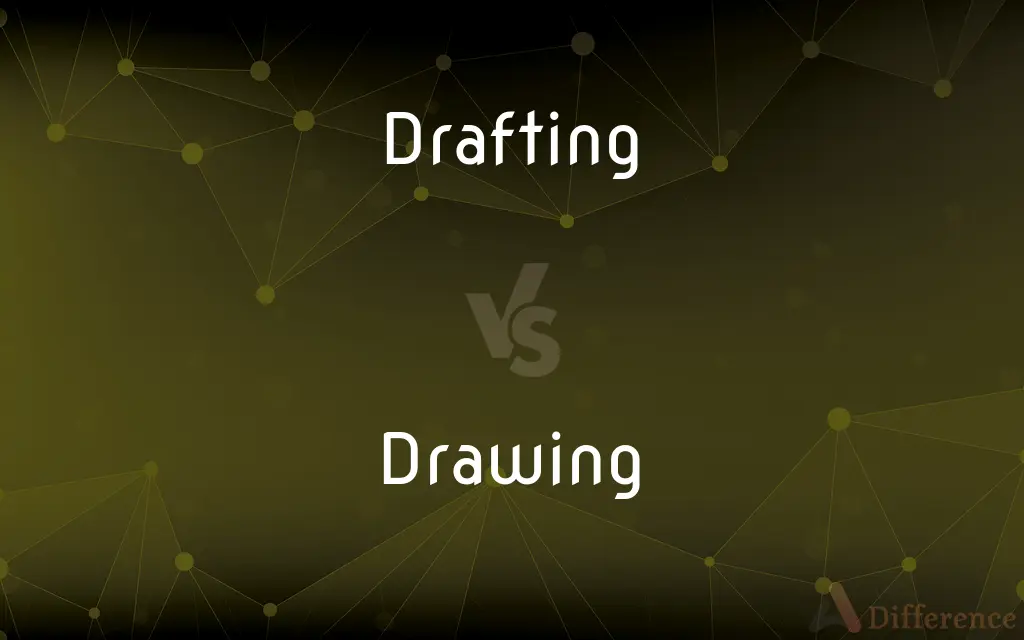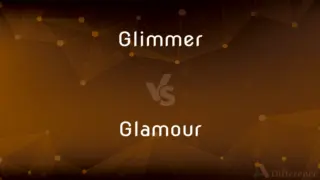Drafting vs. Drawing — What's the Difference?
By Maham Liaqat & Urooj Arif — Updated on March 25, 2024
Drafting is a precise, technical process of creating detailed technical drawings, often for architectural or engineering purposes, while drawing is a broader artistic activity that involves creating visuals using various tools and mediums.

Difference Between Drafting and Drawing
Table of Contents
ADVERTISEMENT
Key Differences
Drafting involves creating detailed and precise technical drawings that are used in architecture, engineering, and manufacturing. These drawings provide comprehensive information about dimensions, materials, and processes necessary for construction or production. On the other hand, drawing is a fundamental artistic activity that encompasses a wide range of techniques and styles, from sketching and illustration to fine art.
Drafting is typically performed using specialized tools and software, such as CAD (Computer-Aided Design) programs, which allow for high precision and easy modifications. These tools are essential for creating the detailed schematics needed in technical fields. Drawing, in contrast, can be done with simple materials like pencils, ink, charcoal, or crayons, and it is often more expressive and subjective. While drafting aims for clarity and accuracy to avoid errors in construction or production, drawing focuses on aesthetics, creativity, and individual expression.
The purpose and audience of drafting and drawing also differ significantly. Drafting documents are primarily used by professionals in the construction, engineering, and manufacturing industries as blueprints for building structures or creating products. These documents must be universally understood by all stakeholders involved. Conversely, drawings are created for a wide range of audiences, including art enthusiasts, the general public, or the artist themselves, with the intention of conveying artistic vision, ideas, or emotions.
Educational paths for drafting and drawing diverge based on their distinct focuses. Drafting education often includes studying technical drawing, CAD software, and specific industry standards. It might be part of engineering or architectural studies. Drawing education, however, might focus on artistic techniques, history of art, and developing personal style, and can be pursued through art schools or self-guided learning.
Despite these differences, drafting and drawing share common ground in the fundamental skills of visual representation. Both require an understanding of space, dimension, and perspective to create accurate and effective visuals. However, where drafting is constrained by the need for precision and adherence to specific standards, drawing allows for greater freedom and exploration of personal expression.
ADVERTISEMENT
Comparison Chart
Definition
Creation of precise technical drawings for engineering or architectural purposes.
Artistic activity of creating visuals with various tools and mediums.
Purpose
Provide detailed information for construction or production.
Express artistic vision, ideas, or serve as a conceptual visualization.
Tools/Software
CAD programs, technical pens.
Pencils, ink, charcoal, crayons, digital tablets.
Precision
High precision and adherence to standards.
Varies, can be highly detailed or abstract and expressive.
Audience
Professionals in construction, engineering, manufacturing.
Art enthusiasts, general public, the artist themselves.
Compare with Definitions
Drafting
Use of CAD software to produce precise schematics.
Drafting the circuit design required advanced CAD skills.
Drawing
Serving as conceptual art or for pure enjoyment.
The concept artist's drawing brought the character to life.
Drafting
The process of creating detailed technical drawings for construction or manufacturing.
The architect's drafting of the new building was meticulous.
Drawing
The art of representing objects or forms on a surface.
Her drawing of the landscape captured its beauty perfectly.
Drafting
Creating blueprints that serve as a guide for construction projects.
The construction team relied heavily on the drafting of floor plans.
Drawing
A form of personal expression through visual art.
Drawing has always been her way to express emotions.
Drafting
A profession requiring knowledge of engineering or architectural standards.
He pursued a career in drafting to blend his love for design and precision.
Drawing
Techniques ranging from sketching to detailed illustration.
The artist's drawing technique evolved over the years.
Drafting
Emphasis on accuracy and detail to prevent errors.
Drafting the machine part required exact measurements to the millimeter.
Drawing
Utilizing various mediums like pencil, ink, or digital tools.
He preferred drawing with charcoal for its texture.
Drafting
The systematic representation and dimensional specification of mechanical and architectural structures.
Drawing
Drawing is a form of visual art in which an artist uses instruments to mark paper or other two-dimensional surface. Drawing instruments include graphite pencils, pen and ink, various kinds of paints, inked brushes, colored pencils, crayons, charcoal, chalk, pastels, erasers, markers, styluses, and metals (such as silverpoint).
Drafting
Present participle of draft
Drawing
The act or an instance of drawing.
Drafting
The act or process of producing a technical drawing, or draft.
Drawing
The art of representing objects or forms on a surface chiefly by means of lines.
Drafting
A profession, usually related to making technical drawings for architecture, engineering, or manufacturing.
Drawing
A work produced by this art.
Drafting
The practice among ground vehicle drivers or cyclists of following in a close line to reduce wind resistance.
Drawing
Present participle of draw
Drafting
A method of preparing fibers for weaving.
Drawing
A picture, likeness, diagram or representation, usually drawn on paper.
Drafting
Writing a first version to be filled out and polished later.
Drawing
The act of producing such a picture.
Drafting
The craft of drawing blueprints.
Drawing
Such acts practiced as a graphic art form.
Drafting
A creation of artistic drawings.
Drawing
The process of drawing or pulling something.
Proverb: An official is great in his office as a well is rich in drawings of water.
Drafting
Writing a first version to be filled out and polished later
Drawing
An act or event in which the outcome (e.g., designating a winner) is selected by chance in the form of a blind draw, notably of lots; especially such a contest in which a winning name or number is selected randomly by removing (or drawing) it from a container, popularly a hat.
Drafting
The craft of drawing blueprints
Drawing
A small portion of tea for steeping.
Drafting
The creation of artistic drawings;
He learned drawing from his father
Drawing
The act of pulling, or attracting.
Drawing
The act or the art of representing any object by means of lines and shades; especially, such a representation when in one color, or in tints used not to represent the colors of natural objects, but for effect only, and produced with hard material such as pencil, chalk, etc.; delineation; also, the figure or representation drawn.
Drawing
The process of stretching or spreading metals as by hammering, or, as in forming wire from rods or tubes and cups from sheet metal, by pulling them through dies.
Drawing
The process of pulling out and elongating the sliver from the carding machine, by revolving rollers, to prepare it for spinning.
Drawing
The distribution of prizes and blanks in a lottery.
Drawing
An illustration that is drawn by hand and published in a book or magazine;
It is shown by the drawing in Fig. 7
Drawing
A representation of forms or objects on a surface by means of lines;
Drawings of abstract forms
He did complicated pen-and-ink drawings like medieval miniatures
Drawing
The creation of artistic drawings;
He learned drawing from his father
Drawing
Players buy (or are given) chances and prizes are distributed according to the drawing of lots
Drawing
Act of getting or draining something such as electricity or a liquid from a source;
The drawing of water from the well
Drawing
The act of moving a load by drawing or pulling
Common Curiosities
What is drafting used for?
Drafting is used to create precise technical drawings for architectural, engineering, and manufacturing purposes.
Do drafters need to be good at drawing?
Drafters benefit from having strong foundational drawing skills, as both require an understanding of space and perspective.
Can drawings be used as technical documents?
While drawings can be detailed and informative, they usually do not serve as technical documents unless they meet the specific standards required in drafting.
Can drawing involve precision like drafting?
While drawing can be detailed and precise, it typically does not adhere to the technical standards and conventions of drafting.
How has technology affected drafting and drawing?
Technology, especially CAD software, has revolutionized drafting by increasing precision and efficiency. Digital tools have also expanded the possibilities for artistic drawing.
Is drawing considered an art or a skill?
Drawing is considered both an art form and a fundamental skill, valuable in various artistic and professional contexts.
How do drafters and artists communicate through their work?
Drafters communicate specific technical information required for construction or manufacturing, while artists use drawing to express ideas, emotions, or artistic concepts.
What education is required for drafting?
Education for drafting typically involves studying technical drawing, CAD software, and specific industry standards, often within engineering or architectural programs.
Why is precision important in drafting?
Precision in drafting is crucial to ensure that constructions or products are built accurately, efficiently, and safely according to the design.
What makes drawing a popular hobby?
Drawing is a popular hobby due to its accessibility, the variety of mediums and styles, and the ability to express creativity and personal vision.
Share Your Discovery

Previous Comparison
Glimmer vs. Glamour
Next Comparison
Wellcome vs. WelcomeAuthor Spotlight
Written by
Maham LiaqatCo-written by
Urooj ArifUrooj is a skilled content writer at Ask Difference, known for her exceptional ability to simplify complex topics into engaging and informative content. With a passion for research and a flair for clear, concise writing, she consistently delivers articles that resonate with our diverse audience.














































